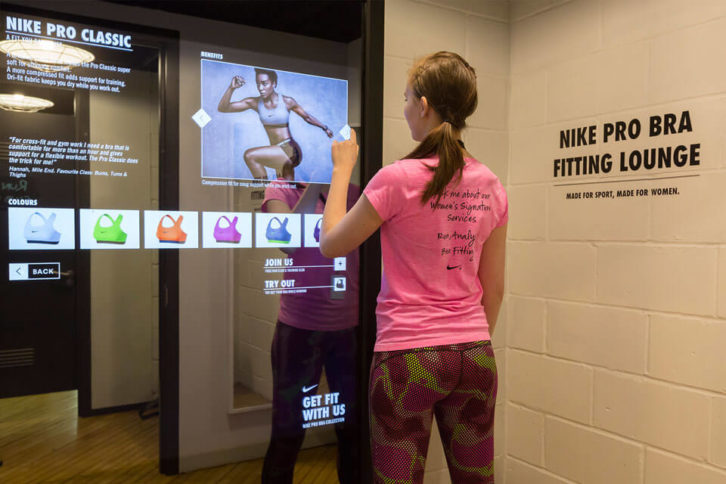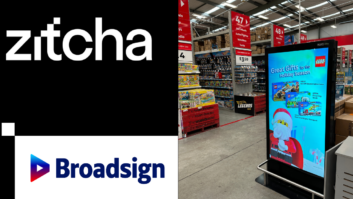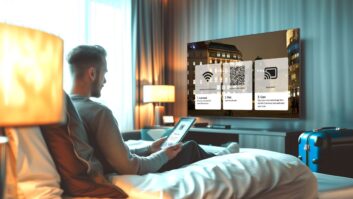Thought physical retail was dead? Think again. Ian McMurray finds out what’s going on as bricks and mortar retailers prepare to invest in AV are fighting back
In November, the number of Brits who went shopping dropped to its lowest level since the 2008 recession, according to researchers, with footfall down 3.2 per cent. That announcement followed successive monthly reports of a decline in consumer visits to so-called ‘bricks and mortar’ retailers. Meanwhile, UK household name chains including Debenhams, Mothercare, House of Fraser, Homebase and Marks & Spencer are reported to be facing torrid times. Across the UK, 6,000 or more UK high street shops are closing each year – and the number is growing.
The word ‘crisis’ doesn’t begin to do the situation justice. Traditional retailers are under threat more than ever before – with most fingers being pointed at the likes of Amazon and Asos. Yes: some of the contributing factors are, perhaps, uniquely British – decreasing levels of disposable income, uncertainty about Brexit, high taxes on retail property – but a general decline in consumer footfall across Europe has been widely reported.
Is bricks and mortar retail dead in the water? Can the tide be turned back? Is it the case for retailers that, as Bob Dylan famously sang over half a century ago: “You better start swimmin’ or you’ll sink like a stone”?

Well established
Digital signage is now well established in the retail sector and has been rolled out in countless malls, stores and restaurants around the world.
“We’re helping retailers transform their stores with digital solutions that are an extension to their overall online and mobile strategy,” notes Jason Cremins (pictured), founder and CEO of digital signage software provider Signagelive. “Integrating with internal systems for stock and sales, combined with audience measurement and other influencers including weather; we create a dynamic rules-based digital signage solution that delivers digital media content optimised each time a media asset is displayed. Our smart playlist capabilities ensure that each media asset is displayed based on the real-time and historic data analysed to ensure maximum impact.”

As Cremins implies: to just say ‘digital signage’ is to do it much less than justice. It is now so much more sophisticated than it was when it was simply a sexier kind of poster, adapting to a wide range of environmental variables as well as being integrated within a retailer’s back end systems.
“We’ve worked with retailers such as Iceland Foods to integrate with their logistics platform to display real-time delivery slot availability on displays in-store so that customers can see at a glance when their frozen food can be delivered at home,” Cremins continues.
And: digital signage is proven to work.
“When Iceland advertised coconut water on in-store digital displays, sales increased by 700 per cent,” Cremins smiles.
The technology is far from standing still. While Cremins describes how the best digital signage systems dynamically respond to key influencing factors, AI and machine learning are taking that dynamism to a new level.
Targeted marketing
“By utilising CCTV analytics technology within retail stores, businesses can really get the most out of their AV technologies as a personalised marketing tool,” explains Lucy Meredith, product marketing manager at Panasonic Business. “For example, facial recognition technology can log the age and gender of the visitor as they walk into the store, and change the content on the digital signage to match the likely preferences of that individual. This is incredibly useful for businesses as they can segment their marketing, increasing the likelihood of purchase. For marketing teams, this approach provides a rich stream of data that helps analyse the patterns of their customers to allow more targeted marketing in the future.”
There are countless examples of the positive impact of technology in stores. Such has been the success of digital signage that retailers are increasingly looking to adjacent technologies to help them achieve their goals in terms of footfall and sales. And: those technologies can bring a great deal.
“It’s the retail market in particular that has inspired many of the innovations we have developed in recent years,” says Ben Kershaw, managing director of Pro Display, a manufacturer specialising in innovative display solutions. “For example, Rear Projection Switchable Glass, which is a development of our Switchable Glass privacy solution, has been developed to extend projection functionality to PDLC [polymer-dispersed liquid crystals] privacy screens and windows, opening up new worlds of technological creativity and productivity. Likewise, the development of Interactive Mirror Displays gave touch capability to mirror screens, enabling engaging use of product selectors and augmented reality in changing rooms, amongst other places. The continuously evolving retail market is an ideal innovation ground.”
“Retailers are looking to modernise their stores through engaging technology which creates a new experience for consumers,” believes Meredith. “Technology such as connected digital signage, Panasonic’s LinkRay LightID based information sharing, and our Space Player – a hybrid lighting solution, which combines the functions of traditional lighting and video projectors in a single spotlight design – can be used to interact with customers and make them feel like they are at the centre of the retail experience, making them more likely to remember the experience and return to the store.”
Rising star
The rising star in retail technology could be said to be VR/AR – and especially the latter.
“Augmented reality as a product visualisation tool gives retailers the opportunity to provide their customers with a product experience unlike any other,” claims Chris Elson, client development manager at Diverse Interactive, who create augmented and virtual reality experiences. “AR is the perfect tool for products that are often difficult to demonstrate when away from their natural environment; that is complex or intricate in design; or that are, in many instances, masked by some sort of casing. The almost ‘X-ray vision’ capabilities of augmented reality make it entirely possible to explain product USPs in an exciting and engaging way. And: it’s all backed up with a reporting backend structure that tracks customer interactions with the AR product demonstrations. That means that the retailer has at their disposal a level of insight into customer behaviour that’s previously not been possible.”
“Having an in-store AR experience is in itself a major drawcard to many, because it turns the retailer’s physical space into a desirable destination once again, because of its unique appeal,” he adds.
“AR has the capacity to not only engage with retail customers on a new level, but also drive footfall in-store once again. And what we know about engaged customers is that they spend more, buy more often, they become advocates of the brand and so on.”

Examples of how he has seen AR used have included the ability to ‘place’ a car on a customer’s driveway, or a sofa into their lounge to see whether it will match the curtains. Elson is quick to point out that AR should never be used as a gimmick, but always as a tool.Unprecedented opportunities
In fact, there are so many technologies out there vying for retailers’ attention. LED is transforming what’s possible with videowalls, opening up unprecedented creative opportunities. Shopping experience company Outform reports that Van Heusen created a retail environment complete with a ‘Virtual Trial’ mirror which lets users see how outfits would look on them by simply scanning the item’s barcode and standing in front of the mirror as virtual garments are projected onto their reflection. Holography and 3D projection – such as Kino-mo’s Hypervsn – are rapidly gaining traction. Companies like Endpoint are transforming wayfinding signage into sales floor assets rather than their historically more prosaic function. Transparent LCD showcases are also offering new ways to engage an audience – and can be augmented with touch foils or frames to provide interactivity.
That ‘engagement’ to which Elson referred echoes what Meredith said about a store visit being memorable – and, according to most commentators on the retail market, it is the most-craved goal – but the quest to achieve it extends far beyond the store walls. ‘Omnichannel’ is a word frequently heard in digital signage circles to describe how retailers look to engage with customers at every touch point – whether the retail floor, the web site, social media, advertising or direct mail.
“Increasingly, we’re seeing high street retailers use technology to bridge the gap between online and in-store experiences to ensure they complement – rather than compete with – each other,” notes Ben Holmes, head of display at Samsung. “Such solutions, including those that we offer, enable multichannel usage of marketing content to truly reflect the online experience in physical locations, from sales promotions adaptable to the weather to short videos and in-store social media campaigns.”
https://www.youtube.com/watch?v=o4trf7bGzI0
Buzzworthy
Kershaw picks up on the multichannel/omnichannel idea, and also sees an opportunity to indulge in something much beloved by marketer.
“Many of our products offer the opportunity to produce unique and buzzworthy content, helping to mobilise the investment to remain productive out of the store,” he says. “For example, consumers seeing via social media that a business has a particularly hyped window display or in-store feature may encourage customers to visit when they would not have done otherwise.”
For many retailers, bridging the gap between the real world and the virtual world – and increasing engagement – is all about embracing consumers’ use of their mobile phones. Panasonic’s Meredith has an example.
“To improve the interactivity of digital signage, retail stores can combine it with technologies such as LinkRay,” she explains. “This platform uses LED light to transmit content to mobile devices, turning digital signage displays, signboards and light sources into 1-2-1 marketing tools for smartphones. This can augment visitor experiences in retail as it allows users to easily access information about the products available, even in crowded retail environments. It also means that retailers can improve the offline/online shopping experience: for instance, LinkRay-enabled displays would allow customers to purchase items from a shop window even when the store is closed.”
There is, of course, no such thing as a one size fits all technology solution for every retailer – and, as Pro Display’s Kershaw points out, much depends on where any given store is in terms of its maturity, its objectives – and even its location.
Fundamental motivation
“For example,” he says, “a new store in the middle of a competitive shopping centre may be focused more on standing out than an established store located in a small retail park who, with steady footfall, may look to focus more on the customer experience instead. In this case, the shopping centre store motivated to increase brand awareness may look to invest in a large Digital Glass projection screen, which offers a very cost-effective and energy-efficient alternative to LCD video walls of equivalent size. The store interested in developing the customer experience may gravitate instead to more engaging technology solutions that can be used in store such as touch screen displays with games, product catalogues or self-service applications.”
“Both reasons for investing in a display system may be different,” he continues, “but the fundamental motivation of increasing sales and being better than the competition remains.”
The $64 million question is, of course: is deploying technology an expense – or an investment? The industry is clear. Whether it’s measurable increases in sales or footfall, repeat business from retailers or customer feedback – retailers are seeing a return.
Diverse Interactive’s Elson has a strong word of advice, however.
“Now is the time that retailers should be developing proofs of concept, and testing AR as a tool because, before too long, when AR becomes a mainstream marketing channel, those that have seized the opportunity now to learn about its capabilities, will reap the rewards relevant to a significantly more educated customer. AR commerce is going to be huge, and about to begin.”
His guidance is certainly applicable across the board when it comes to evaluating and deploying new technologies for retail: competitive advantage will invariably lie with first movers.
Huge transformation
“The retail industry is in the midst of a huge transformation, driven by the challenges presented by the convenience and innovation of online shopping,” says Samsung’s Holmes. “High street brands are increasingly finding themselves asking how they can improve their in-store offering and increase footfall into store. Technology can be a huge catalyst for change and help businesses respond to the ever-growing retail challenge.”
It’s all too easy, of course, to believe that bricks and mortar retailers’ competition is entirely with on-line retailers. That is, of course, fundamentally not so. Physical stores are continuing to compete with each other for footfall, sales and profits, as Kershaw noted. In challenging times, that competition has not become less fierce. AV technology can provide a vital differentiator that will pull consumers into one store rather than into another.
Inevitably, however, there is much focus on bringing consumers back to the high street. And here’s the thing. Imagine being able to touch and feel something before you buy it. Imagine buying clothes that you know will fit you. Imagine not having to create an account before actually buying something. Imagine not having to wait in all day for a delivery that hasn’t got lost in transit or damaged. And, best of all: imagine being able to have something the moment you’ve decided you want it. You’re imagining the world of bricks and mortar retail. It has so much going for it. All it has to do make shopping in-store interesting – make it an engaging experience – to entice you into that world.
To return to Bob Dylan: “There’s a battle outside, and it’s raging”. AV technology is increasingly proving to provide that enticement and to enable the battle to be won.
www.diverseinteractive.com
www.panasonic.eu
www.prodisplay.com
www.samsung.com
www.signagelive.com







